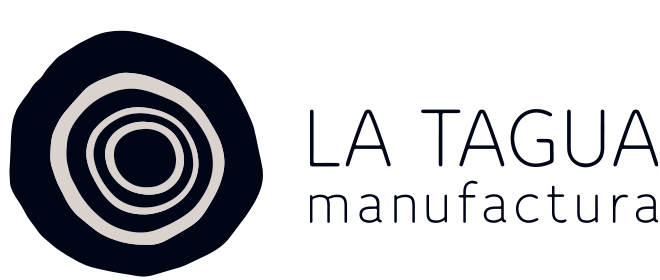Materials
The combination of carefully selected natural materials creates unique designs inspired by Colombian passion. Each handmade piece of jewelry is unique thanks to the structure, form, and color of the natural materials and will last for timeless pleasure.
Tagua nut
- a natural alternative to ivory
- hard as stone
– light on the skin
The Tagua nut is the seed of the ivory palm which grows in the rainforests of South America. Phytelephas macrocarpa is the scientific name for the ivory palm which is close in meaning to natural ivory. Its creamy color, consistency and appearance make the Tagua nut an eco-friendly and animal-friendly alternative to ivory. Despite its tough appearance, the processed Tagua nut is surprisingly light and its supple, warm structure makes this natural material pleasant to wear on the skin.
Fresh Tagua nuts are gel-like in their consistency and must be dried before they can be crafted into jewelry. After drying, the Tagua nuts are ground, carved into shape, dyed and finally polished for the final product.
LA TAGUA MANUFACTURA mainly uses Tagua nuts from Colombia, which saves long transport distances and protects the environment while supporting the regional economy. For many people, the Tagua nut which grows in the wild in the tropical rainforests of Colombia is an important economic means for their family. Working with the Tagua nut helps the community to value natural resources and learn that protecting their natural environment is worthwhile.
It’s a long journey for the Tagua nut from the rainforests of Colombia to the finished piece of jewelry. Transport conditions are difficult – Tagua nuts are harvested by hand and often have to be transported by boat from the impassable areas of the rainforest. After a lengthy drying process, much hard work and care is taken to make the Tagua nut a coveted and unique natural product.
Only Tagua nuts of impeccable quality are used for crafting LA TAGUA MANUFACTURA jewelry.
Orange peel
With freshly squeezed juice served on almost every street corner, orange peel is widely available in Colombia. Unique pieces of jewelry are made by upcyling orange peel and combining it with the Tagua nut and other natural materials. The fresh scent accompanies the wearer for a long time and the exciting surface of this natural material can be used in many ways.
Melon seeds
Melon seeds don’t go to waste either and are also used to create our unique handcrafted jewelry. Cleansed and dyed melon seeds are lovingly transformed into artisan necklaces, bracelets and earrings. Wearing our jewelry invigorates the wearer with a touch of Caribbean summer thanks to the light natural material.
Acai
The Acai palm is native to the pacific rainforest and grows up to 20 meters high. Its fruit and heart of palm are edible, and Acai berries are well known as a superfood. But they are also highly sought after in the jewelry sector. To make jewelry out of the seeds, they are first dried, dyed and then polished.
Chirilla
Chirilla seeds are obtained from the Canna flower (Canna indica), also known as the “Indian flower tube”. The plant grows in the tropical and subtropical areas of Latin America, but thanks to its vivid flowers it is also cultivated as an ornamental plant in Europe. The spherical seeds are medium to dark brown and were used by the Incas to weigh gold, as they have a constant weight. The roots of the plant are edible and the leaves are still used today for wrapping food.
Iraca
Iraca is a tropical palm which is an important source of palm fibers. The extremely robust fibers are used for making jewelry, bags and many accessories. In Colombia, a whole village specializes in making accessories from Iraca fibers. Usiacurí is home to the best craftspeople and family businesses who put much passion and energy into making accessories from Iraca fibers by hand.
Traditional Molas made by Guna Indians
The Guna Yala live in the coastal zone of the Caribbean Sea, which stretches from Colombia to Panama. Today many Guna live on the San Blas Islands, which are located on the mainland of Panama. A centuries-old tradition of the Guna is the Mola, which are uniquely crafted by the Guna women.
In the language of the Guna, Mola was originally the word for "blouse", or the front and back panels of the blouse which are sewn from different fabric layers. Colorful patterns are created by skillfully sewing layers of fabric together.
The traditional designs of the Mola are mostly geometric patterns but realistic and abstract representations of animals, plants and people that often have a religious and cultural significance are becoming more commonplace. Some colors also have symbolic meaning: Black, orange and burgundy feature often in designs.
Although Molas were traditionally worn exclusively as part of a blouse, today many different accessories are made from the hand-sewn fabric layers. Traditionally crafted Molas are used to beautify cases, bags, and leather wallets transforming them into exclusive hand-crafted products.
Totumo
The calabash is a tropical pumpkin. Its shell is waterproof and as hard as coconut. While the flesh is only used as food in farming, the hard shell is mainly used to make practical utensils for the household and musical instruments. On Colombia's Caribbean coast, for example, "Sancocho", a kind of stew, is traditionally served from calabash bowls.
Now there are also individually handmade jewelry and accessories made of this light but very robust natural material.
Putting the environment first
All fabrics used in our bracelets, earrings and necklaces are made from cotton. We aim to incorporate certified fair-trade organic cotton from South America in our designs. We are currently looking for suitable suppliers.
We have already changed our jewelry packaging and now it's made of recyclable papers, which are approved by the Forest Stewardship Council (FSC).
On the other hand, our print materials are mainly made with this recyclable papers.
